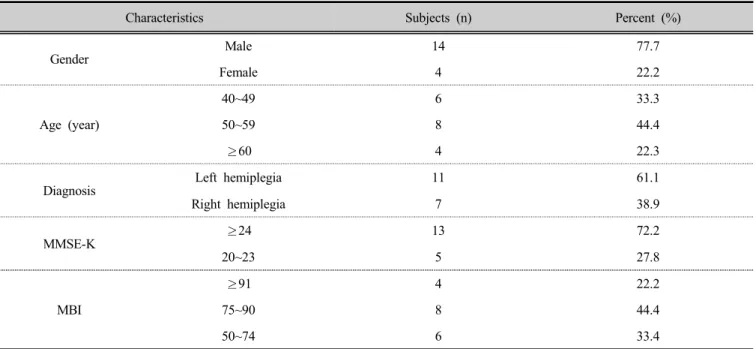Correlation of Cognitive Function, Activities of Daily Living and Driving Performance in Stroke Hemiplegic Patients
Kwak Hosoung, OT, Ph.D Yoo Chanuk, OT, Ph.D
⧧Dept. of Occupational Therapy, Woosong University, Professor
Abstract
Purpose : This study aims to evaluate the correlation of cognitive function, activities of daily living (ADL), and driving performance in stroke hemiplegic patients residing in Korea.
Methods : Subjects of the study were 18 stroke hemiplegic patients admitted to hospitals situated in Seoul. A clock drawing test (CDT), a modified Barthel index (MBI), and a virtual reality driving simulator (Eca faros-driving simulator) were used to examine their cognitive function, their ADL ability, and their driving skills, respectively.
Results : Driving skills of stroke hemiplegic patients were shown to be associated with the CDT evaluation tool (r=−.777) (p<.001), but they were found to have any correlation with MBI (r=−.022) (p>.05). Additionally, an individual’s CDT showed that the driving simulator evaluation result (pass/fail) could be discriminated with a sensitivity of 100.0 %, a specificity of 40.0 %, and an accuracy of 66.7 %. The result confirmed that the CDT is a useful evaluation tool for screening driving ability in people with stroke. But the MBI did not show any significant results (sensitivity of 62.5 %, specificity of 40.0 %, and predicted the results of the simulator with 50.0 % of accuracy) (p>.05).
Conclusion : This study shows that cognitive function influences the driving performance in people with stroke. Driving skills of stroke hemiplegic patients are seen to be highly related to CDT. In the field of driving rehabilitation, these findings could be useful for evaluating driving skills relating to CDT. Furthermore, the study results will set a guideline for domestic occupational therapists to use the evaluation tool for assessing driving abilities in people with stroke.
Key Words : activities of daily living, cognitive function, driving performance, stroke
⧧
Corresponding author : Yoo Chanuk, chanukyoo@gmail.com
1)
Received : March 20, 2020 | Revised : April 13, 2020 | Accepted : May 1, 2020
※ This study was supported by research funds from the Woosong University in 2020.
Ⅰ . Introduction
Driving is a complicated high-level performance that requ ires motor control abilities including muscular strength, coor dination, range of motion, and cognitive abilities including attention and judgment (Anstey et al., 2005). Additionally, driving is an important activity that enhances independent move, social interaction, and integration in the local commu nity and improves people’s satisfaction by helping out the occupational activity, shopping, and social participation in t heir daily activities (Johnston et al., 2005; Lane & Benoit, 2011).
In the case of patients with central nervous system disord ers like stroke, their diseases influence driving performance abilities including motor control, cognition, and perception t hat causes driving cessation (Akinwuntan et al., 2002; Mars hall et al., 2007). Driving performance of stroke patients re quires cognitive abilities, such as attention, reaction time, vi sual attention, thinking ability, and environmental perception during driving. Particularly, their cognitive abilities are one of the most important factors to draw their driving performa nce behavior (Akinwuntan et al., 2012). Due to disorders of cognitive abilities, stroke patients can experience driving ce ssation (Marshall et al., 2007).
The damage of cognitive functions is a disability that mo st stroke patients have, and about 25 % of patients who hav e had a stroke for over 3 months show a serious level. Parti al damage to cognitive functions appears on 50~75 % of pa tients (Desmond et al., 2000). The damage cognitive functio n is one of the factors that increase the ratio of traffic accid ent risk and has a bad influence on driving (Rizzo et al., 20 01). More so, overall driving performance ability is evaluate d using activities of daily living (ADL) and instrumental act ivities of daily living scales, which can judge whether peopl e are eligible to drive through comprehensive driving evalua tion (Dickerson et al., 2014).
Stroke patients’ cognitive function relating to driving abil ity can be analyzed with a clock drawing test (CDT), which
is known to evaluate a patient’s driving performance in the way of checking his or her space perception ability and he mineglect during their driving (Manning et al., 2014). Freun d (2005) reported that the CDT based scale is a reliable an d useful evaluation tool to identify subjects who need the e valuation for driving rehabilitation. Furthermore, Shulman (2000) reported that CDT is needed for driving rehabilitatio n because it presents cognitive factors appropriately in the course of evaluating clock drawing.
MBI used in evaluating ADL is a useful tool to evaluate a stroke patient’s basic activity level (Shah et al., 1989). Th e MBI provides a therapist with information on a stroke pat ient’s general functions, thus, it’s an appropriate evaluation tool to determine a suitable moment for the patient’s drivin g rehabilitation despite that it’s not a tool to measure a parti cular driving skill (Akinwuntan et al., 2006). According to Park’s research (2017), the MBI score is a useful evaluation tool to predict a recommended time of driving rehabilitation for stroke patients.
As such, evaluating cognitive abilities including visual pe rception and ADL for driving performance is very importan t in predicting and determining whether a stroke patient can drive. Nevertheless, there is not much research on the analy sis of correlations between cognitive functions, ADL, and d riving performance with the use of MBI and CDT. Therefor e, this study tries to analyze the correlations between stroke patients’ cognitive abilities, ADL, and driving performance.
Ⅱ . Methods
1. Subjects
Subjects of the study were patients admitted to the
rehabilitation hospital B and hospital J, both situated in
Seoul, Korea, which gave their consent to participate fully
in the study. This study was deliberated and approved by
the institutional review board of Soonchunhyang University
(SCH-IRB), and the criteria for inclusion in the trial and general features of subjects are as follows (Table 1).
1) A patient diagnosed with a stroke by a neurologist or a physiatrist
2) A patient that experienced a stroke at least 6 months
ago
3) A patient with driving experience of 1 year or longer 4) A patient with a mini-mental status examination–Korea
(MMSE-K) score of 20 or above and understood the trial and was capable of executing the trial
Characteristics Subjects (n) Percent (%)
Gender Male 14 77.7
Female 4 22.2
Age (year)
40~49 6 33.3
50~59 8 44.4
≥60 4 22.3
Diagnosis Left hemiplegia 11 61.1
Right hemiplegia 7 38.9
MMSE-K ≥24 13 72.2
20~23 5 27.8
MBI
≥91 4 22.2
75~90 8 44.4
50~74 6 33.4
MMSE-K; mini mental status examination–Korea, MBI; modified barthel index
Table 1. General demographic characteristics of participants (n=18)
2. Procedures
One examiner had a 1:1 interview. Before the interview, the researcher practiced several times to fully understand the procedure and to have an effective interview. The researcher fully explained the purpose and method of the study to the subjects and thus, obtained their consent. The researcher conducted the CDT and MBI to evaluate the subject's cognitive function and ADL ability. The subjects who completed all the tests took the Eca faros-driving simulator test for evaluating its driving performance.
3. Instrumentation 1) Clock drawing test
A CDT is a tool for evaluating the cognitive function (Shulman, 2000). In this study, the production task-based clock drawing method, developed by Yim (2010) was used.
The subject was instructed verbally by the evaluator not to show the model of the watch and asked to draw an analog watch under one condition. Free drawing conditions were used for the CDT and the 15-point rating method suggested by Freedman et al. (1994) was used for the rating system.
Inter-tester reliability (ICC = 2.1) of CDT showed .75 (p<.01) and the correlation coefficient between the MMSE-K and the CDT showed r = .77 (p<.01) (Lee et al., 2011).
2) Modified Barthel index
MBI is a tool for evaluating the degree of independence
CDT MBI DS (P&F)
CDT 1
MBI .071 1
DS (P&F) -.777
*-.022 1
*


